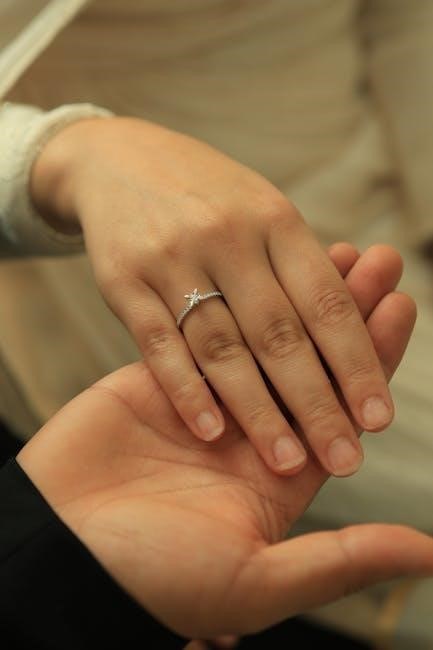
O-Ring groove sizing is critical for ensuring proper sealing in various applications. This guide provides essential principles, materials, and best practices for optimal groove design and sealing performance.
1.1 Importance of Proper Groove Dimensions
Proper O-ring groove dimensions are essential for ensuring optimal sealing performance and preventing issues like leakage or premature wear. Incorrect dimensions can lead to insufficient sealing, reduced efficiency, or even system failure. Standards like AS568B and ISO 3601 provide guidelines to ensure compatibility and reliability. Proper groove sizing balances compression ratios, material deformation, and surface contact, critical for both static and dynamic applications. Engineers must consult standardized tables to select the correct groove width, depth, and cross-section for their specific O-ring size and application. This ensures long-term durability and consistent sealing performance across various industries and operating conditions.

1.2 Overview of the O-Ring Groove Sizing Guide
This guide provides comprehensive insights into O-ring groove sizing, covering essential principles, materials, and best practices. It includes standardized dimension tables, tolerances, and surface finish requirements, ensuring optimal sealing performance. The guide addresses both static and dynamic applications, offering detailed guidelines for groove width, depth, and cross-section selection. Resources like the AS568B standard and ISO 3601 are referenced to ensure compatibility and reliability. Engineers can utilize this guide to design grooves that balance compression ratios, material deformation, and surface contact, ensuring long-term durability and consistent performance across various industries and operating conditions.

Understanding O-Ring Standards
O-Ring standards like AS568B and ISO 3601 provide detailed specifications for groove dimensions, ensuring compatibility and interchangeability. These standards guide engineers in designing optimal sealing solutions.
2.1 AS568 Standard for O-Ring Groove Dimensions
The AS568B standard is a widely recognized specification for O-ring groove dimensions in North America. It provides detailed guidelines for groove design, ensuring compatibility and interchangeability across industries. The standard specifies dimensions for various O-ring sizes, including groove width, depth, and radii, to ensure optimal sealing performance. Engineers can refer to standardized dimension tables that correlate O-ring cross-sections with recommended groove dimensions. Resources like Global O-Ring and Seal and allorings.com offer comprehensive size charts and cross-reference data. Additionally, the AS568 standard covers both inch and metric sizes, making it a versatile tool for designers worldwide. Proper adherence to these specifications ensures reliable sealing in diverse applications.
2.2 ISO 3601 Standard for O-Ring Dimensions
The ISO 3601 standard provides international guidelines for O-ring dimensions, ensuring global compatibility and consistency. It specifies groove dimensions, tolerances, and material requirements for O-rings used in various applications. Unlike the AS568 standard, ISO 3601 focuses on metric dimensions, catering to European and other international markets. It includes detailed tables for O-ring sizes, groove widths, and depths, ensuring precise fitment. Resources like the International Organization for Standardization and Engineering ToolBox offer charts and calculators for ISO 3601 compliance. Adhering to these standards minimizes leaks and ensures reliable sealing performance across diverse industries. Proper implementation requires careful consultation of ISO guidelines.

Key Considerations for Groove Design
Material compatibility, cross-section, surface finish, and clearance are critical factors. Proper groove design ensures optimal sealing performance and prevents premature wear or failure.
- Material compatibility ensures durability.
- Cross-section affects sealing efficiency.
- Surface finish prevents leakage.
- Clearance avoids excessive stress.
3.1 Material Selection for O-Rings
Selecting the right material for O-rings is crucial for ensuring durability and performance. Common materials include Nitrile (NBR), Viton (FKM), Silicone (VMQ), and Teflon (PTFE). Each material offers unique properties, such as resistance to chemicals, temperature, or abrasion. Nitrile is ideal for oils and fuels, while Viton excels in aggressive chemical environments. Silicone is preferred for high-temperature applications, and Teflon provides excellent resistance to corrosive substances; The choice depends on the operating conditions, including temperature range, chemical exposure, and application type. Proper material selection ensures optimal sealing and extends the lifespan of the O-ring.
3.2 Cross-Section and Shaft Diameter Range
The cross-section of the O-ring and the shaft diameter range are critical factors in groove design. The cross-section determines the sealing performance and load-carrying capacity, while the shaft diameter influences the groove’s overall dimensions. Proper alignment between the O-ring’s cross-section and the shaft ensures even compression and prevents deformation. Tolerances must account for thermal expansion and mechanical stress. Typically, the cross-section ranges from 0.139″ to 0.275″ for standard applications. The groove width and depth are calculated based on the O-ring’s dimensions and the shaft’s diameter to ensure optimal fit and functionality.
Groove Dimensions and Tolerances
Groove dimensions are calculated based on the O-ring’s cross-section and shaft diameter, ensuring proper fit and sealing performance. Tolerances must be tightly controlled to prevent leakage or excessive wear, maintaining optimal sealing integrity and extending service life.

4.1 Groove Width and Depth Specifications
Groove width and depth are critical for proper O-ring seating and sealing performance. The groove width typically matches the O-ring’s cross-sectional diameter, while the depth ensures the O-ring sits flush with the groove’s opening. Proper specifications prevent over-compression or inadequate sealing. Standards like AS568 and ISO 3601 provide detailed guidelines for these dimensions, ensuring compatibility with standard O-ring sizes. The groove depth is usually slightly larger than half the O-ring’s cross-section to allow for proper compression without excessive deformation. Accurate machining of these dimensions is essential for reliable sealing in various applications.
4.2 Surface Finish Requirements
The surface finish of the groove is crucial for ensuring proper O-ring sealing performance. A smooth surface prevents leaks and ensures even compression. Standards recommend a surface roughness of Ra 32 µin (0.8 µm) or better for optimal sealing. Rough surfaces can lead to premature wear and leakage, while overly polished surfaces may reduce seal effectiveness. Proper machining techniques, such as milling or turning, should be used to achieve the desired finish. Inspection of the groove surface is essential to ensure compliance with specified tolerances and standards, guaranteeing reliable sealing in various applications.
Squeeze and Compression Ratios
Squeeze and compression ratios are critical for ensuring proper O-ring sealing. The squeeze ratio ensures the O-ring is adequately compressed, while the compression ratio maintains seal integrity, preventing leakage and ensuring long-term performance.
5.1 Recommended Squeeze Ratios for Optimal Sealing
The squeeze ratio, defined as the difference between the groove diameter and the O-ring diameter divided by the O-ring diameter, is critical for proper sealing. A recommended squeeze ratio typically ranges between 10% and 30%. This ensures adequate compression without over-compressing the O-ring, which can lead to premature failure. The ideal ratio depends on the application, with higher ratios (20-30%) often used for dynamic or high-pressure applications, while lower ratios (10-15%) may suffice for static or low-pressure scenarios. Always consult industry standards like AS568 or ISO 3601 for specific recommendations.
5.2 Effects of Compression on O-Ring Performance
Compression plays a vital role in ensuring the proper functioning of an O-ring. Excessive compression can lead to increased wear, heat generation, and reduced seal life, while insufficient compression may result in leakage. The ideal compression ensures the O-ring fills the groove evenly, creating a reliable seal. Material selection also influences compression tolerance, with elastomers like nitrile rubber offering better resistance to compression set than softer materials. Properly designed compression ensures optimal sealing performance, minimizing the risk of failure in both static and dynamic applications. Always refer to material specifications and industry standards for guidance.

Static vs. Dynamic Seals
Static seals are for non-moving applications, ensuring leakage prevention under constant conditions. Dynamic seals handle motion, requiring durable materials and precise groove design to maintain sealing integrity during movement.
6.1 Design Considerations for Static Seals
Static seals require precise groove dimensions to ensure a tight fit without excessive pressure. Material selection should prioritize resistance to environmental factors like temperature and chemicals. The groove’s surface finish must be smooth to prevent leaks, and the O-ring should be slightly compressed to maintain sealing integrity. Proper alignment is crucial to avoid misplacement, which could compromise the seal. Standards like AS568 provide guidelines for optimal groove width and depth, ensuring longevity and performance in non-moving applications.
6.2 Groove Dimensions for Dynamic Applications
In dynamic applications, where parts move relative to each other, groove dimensions must balance sealing performance with minimal friction. The O-ring groove should be slightly deeper than in static applications to accommodate movement without excessive wear. The cross-section of the O-ring should allow for controlled deformation while maintaining contact with the groove walls. Proper material selection is critical to withstand friction-generated heat and repeated cycling. Standards like ISO 3601 provide guidance for optimal groove dimensions in dynamic seals, ensuring reliability and extended service life in moving systems.

Best Practices for Groove Design
- Ensure precise groove dimensions for optimal O-ring performance.
- Select materials compatible with the application’s operating conditions.
7.1 Clearance and Stretch Considerations
Proper clearance and stretch are critical for ensuring the O-ring functions effectively without excessive wear or failure. Clearance refers to the space between the O-ring and the groove, which must be minimized to prevent leakage while allowing for thermal expansion. Stretch considerations involve the O-ring’s elasticity during installation, as over-stretching can lead to premature failure. The recommended stretch should not exceed 10-15% of the O-ring’s diameter. Additionally, material hardness and temperature fluctuations must be accounted for to maintain optimal sealing performance over time. Always consult size charts to ensure dimensions align with application requirements.
7.2 Avoiding Common Design Mistakes

When designing O-ring grooves, common mistakes can lead to poor sealing performance or premature failure. One major error is using incorrect groove dimensions, which can result in insufficient compression or excessive stress. Another oversight is neglecting surface finish requirements, as rough surfaces can cause leakage or wear. Additionally, ignoring material compatibility or operating conditions, such as temperature and chemical exposure, can compromise seal integrity. To avoid these issues, always consult O-ring manufacturer guidelines and use standardized design tools. Proper material selection and precise machining are essential for reliable sealing performance in any application.
Tools and Resources for O-Ring Sizing
Essential tools include O-ring size charts, cross-reference guides, and online calculators. These resources help ensure accurate groove dimensions and material compatibility for optimal sealing performance.

8.1 O-Ring Size Charts and Cross-Reference Data
O-ring size charts provide detailed measurements for inner diameter, cross-section, and material types, ensuring compatibility with groove dimensions. Cross-reference data helps identify equivalent sizes across manufacturers, simplifying procurement. These resources are critical for engineers to select the right O-ring for specific applications, preventing leaks and ensuring optimal sealing performance. By referencing these charts, designers can verify dimensions and material suitability, reducing the risk of design errors. Regular updates to these charts reflect industry standards and advancements, making them indispensable tools for accurate and efficient groove design.
8.2 Online Calculators for Groove Dimensions
Online calculators for groove dimensions simplify the design process by providing precise measurements based on O-ring size and material. These tools allow engineers to input specific parameters, such as O-ring cross-section, material hardness, and operating conditions, to calculate optimal groove width and depth. Advanced calculators offer features like 3D modeling and real-time adjustments, ensuring accurate results. They also reduce the risk of human error and save time compared to manual calculations. Many calculators are available for free or as part of manufacturer software, making them accessible for designers worldwide.
Case Studies and Real-World Applications
Real-world applications highlight successful O-ring groove implementations in aerospace and automotive industries, showcasing improved sealing performance and reduced leaks, underscoring the guide’s practical benefits.
9.1 Examples of Successful Groove Designs
Successful groove designs are evident in aerospace applications, where precise O-ring sizing ensures leak-free performance in extreme temperatures and pressures. In hydraulic systems, optimized groove dimensions prevent fluid leakage, enhancing system efficiency. Industrial machinery often benefits from custom-designed grooves that withstand heavy-duty cycles. These examples demonstrate how adhering to the sizing guide leads to reliable sealing solutions, reducing downtime and improving overall system performance. Properly designed grooves not only extend O-ring lifespan but also maintain seal integrity in demanding environments, proving the guide’s effectiveness in real-world scenarios.
9.2 Lessons Learned from Failed Seals
Failed seals often result from improper groove dimensions and material incompatibility. Insufficient compression can lead to leakage, while excessive squeeze may cause premature wear. Tolerances not met during manufacturing and improper installation are common pitfalls. These failures emphasize the importance of adhering to O-ring standards like AS568 and ISO 3601. Proper material selection and precise groove design are crucial for optimal performance. By understanding these issues, engineers can design better grooves, ensuring reliable sealing solutions and minimizing system downtime. Attention to these details is essential for achieving long-term sealing integrity in various applications.
Proper O-ring groove sizing is critical for reliable sealing. Adhering to standards, material selection, and precise tolerances ensures optimal performance. Future advancements will enhance sealing solutions further.
10.1 Summary of Key Takeaways
The O-ring groove sizing guide emphasizes the importance of precise dimensions, material compatibility, and adherence to standards like AS568 and ISO 3601. Proper groove design ensures optimal sealing performance by considering factors like squeeze ratios, surface finish, and application-specific requirements. Material selection must align with environmental conditions, and tolerances should be tightly controlled to prevent leakage. Best practices include consulting size charts, using online calculators, and avoiding common design pitfalls. By following these guidelines, engineers can achieve reliable, long-lasting seals in both static and dynamic applications, minimizing the risk of failure and ensuring system integrity.
10.2 Future Trends in O-Ring Groove Design
Future trends in O-ring groove design focus on advancing material science, precision engineering, and integration with smart technologies. Sustainable materials, such as eco-friendly elastomers, are gaining traction to meet environmental demands. Additive manufacturing and 3D printing are enabling complex groove geometries for specialized applications. Additionally, the use of AI-driven design tools promises to optimize groove dimensions for enhanced performance. There is also a push toward miniaturization and high-precision sealing solutions for emerging industries like aerospace and renewable energy. These innovations aim to improve reliability, reduce maintenance, and adapt to extreme operating conditions, ensuring O-ring groove design remains at the forefront of sealing technology.